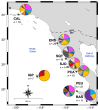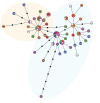Genetic Insights into the Giant Keyhole Limpet (Megathura crenulata), an Eastern Pacific Coastal Endemic: Complete Mitogenome, Phylogenetics, Phylogeography, and Historical Demography
- PMID: 39457427
- PMCID: PMC11507411
- DOI: 10.3390/genes15101303
Genetic Insights into the Giant Keyhole Limpet (Megathura crenulata), an Eastern Pacific Coastal Endemic: Complete Mitogenome, Phylogenetics, Phylogeography, and Historical Demography
Abstract
Background: The giant keyhole limpet Megathura crenulata is a gastropod mollusk (Fissurella superfamily) that is endemic to the eastern Pacific coast from southern California, USA, to Baja California Sur, Mexico. M. crenulata is socioeconomically important as it produces a potent immune-stimulating protein, called Keyhole Limpet Hemocyanin, which is extracted in vivo and utilized for vaccine development. However, ecological studies are scarce and genetic knowledge of the species needs to be improved. Our objectives were to assemble and annotate the mitogenome of M. crenulata, and to assess its phylogenetic relationships with other marine gastropods and to evaluate its population genetic diversity and structure.
Methods: Samples were collected for mitogenome assembly (n = 3) spanning its geographic range, Puerto Canoas (PCA) and Punta Eugenia (PEU), Mexico, and California (CAL), USA. Total DNA was extracted from gills sequenced using Illumina paired-end 150-bp-read sequencing. Reads were cleaned, trimmed, assembled de novo, and annotated. In addition, 125 samples from eight locations were analyzed for genetic diversity and structure analysis at the 16s rRNA and COX1 genes.
Results: The M. crenulata mitogenomes had lengths of 16,788 bp (PCA) and 16,787 bp (PEU) and were composed of 13 protein-coding regions, 22 tRNAs, two rRNAs, and the D-Loop region. In terms of phylogeographic diversity and structure, we found a panmictic population that has experienced recent demographic expansion with low nucleotide diversity (0.002), high haplotypic diversity (0.915), and low φST (0.047).
Conclusions: Genetic insights into the giant keyhole limpet provides tools for its management and conservation by delimiting fishing regions with low genetic diversity and/or genetically discrete units.
Keywords: Fissurella; genetic diversity; mitogenome; population structure.
Conflict of interest statement
The authors have no conflicts of interest to declare.
Figures





Similar articles
-
Hydroids (Cnidaria, Hydrozoa) from Mauritanian Coral Mounds.Zootaxa. 2020 Nov 16;4878(3):zootaxa.4878.3.2. doi: 10.11646/zootaxa.4878.3.2. Zootaxa. 2020. PMID: 33311142
-
Genetics, Gene Flow, and Glaciation: The Case of the South American Limpet Nacella mytilina.PLoS One. 2016 Sep 6;11(9):e0161963. doi: 10.1371/journal.pone.0161963. eCollection 2016. PLoS One. 2016. PMID: 27598461 Free PMC article.
-
Strong population structure and shallow mitochondrial phylogeny in the banded guitarfish, Zapteryx exasperata (Jordan y Gilbert, 1880), from the Northern Mexican Pacific.J Hered. 2014 Jan-Feb;105(1):91-100. doi: 10.1093/jhered/est067. Epub 2013 Oct 11. J Hered. 2014. PMID: 24123495
-
Behavioral thermoregulation and critical thermal limits of giant keyhole limpet Megathura crenulata(Sowerby 1825) (Mollusca; Vetigastropoda).J Therm Biol. 2015 Dec;54:133-8. doi: 10.1016/j.jtherbio.2013.05.007. Epub 2013 Jun 6. J Therm Biol. 2015. PMID: 26615735
-
Phylogeography of endemic Xantus' hummingbird (Hylocharis xantusii) shows a different history of vicariance in the Baja California Peninsula.Mol Phylogenet Evol. 2016 Sep;102:265-77. doi: 10.1016/j.ympev.2016.05.039. Epub 2016 May 31. Mol Phylogenet Evol. 2016. PMID: 27261252 Review.
References
-
- Sowerby G.B. A Catalogue of the Shells Contained in the Collection of the Late Earl of Tankerville: Arranged According to the Lamarckian Conchological System. EJ Stirling; London, UK: 1825. Together with an Appendix Containing Descriptions of Many New Species.
-
- Torres-Moye G. Ph.D. Thesis. University of California; Davis, CA, USA: 2012. Mainland and Island Kelp Forests in Northern Baja California, México: Subtidal Community Structure, Dynamics, and Connectivity for the Design of Marine Protected Areas.
-
- Mau A., Jha R. Aquaculture of two commercially important mollusks (abalone and limpet): Existing knowledge and futures prospects. Rev. Aquac. 2018;10:611–625. doi: 10.1111/raq.12190. - DOI
-
- Miller C., Robbins R. Chemical analysis and vitamin assays of opihi, the Hawaiian limpet. [(accessed on 1 January 2020)];Philipp. J. Sci. 1940 71:141–163. Available online: https://www.cabidigitallibrary.org/doi/full/10.5555/19401401307. - DOI
MeSH terms
Grants and funding
LinkOut - more resources
Full Text Sources

